 The information on this site is from one of the most famous books about the New Medicine (GNM / 5BN): "The Psychic Roots of Diseases" by Björn Eybl. Since September 2025, it is available in the form of an app with many additional features.
The information on this site is from one of the most famous books about the New Medicine (GNM / 5BN): "The Psychic Roots of Diseases" by Björn Eybl. Since September 2025, it is available in the form of an app with many additional features.It was written in german and was translated into more than 10 languages already. German is not freely available, as the rights are held by a publisher, but all these translations are available as ebooks / PDFs for free, as a gift of Björn for you, for the New Earth, for a new time.
In cooperation with Björn, it is splitted on "Disease is Different" into the sections by organ systems and combined with the real cases of our international testimonial / report archive of the related organ system.
LIPS, MOUTH AND THROAT
The mouth and pharynx (throat) are the first part of the digestive tract and at the same time they serve as sound and speech-forming organs. Over the deep-lying, endodermal “intestinal mucous membrane“ lies the ectodermal epithelium, which migrated from the outer skin. Most SBS of lips, mouth, and throat, take place in this superficial mucosa.
Lip Epidermis
Separation conflict
Hard Palate
Self-esteem conflict
Mouth & Pharynx Mucosa
Separation conflict
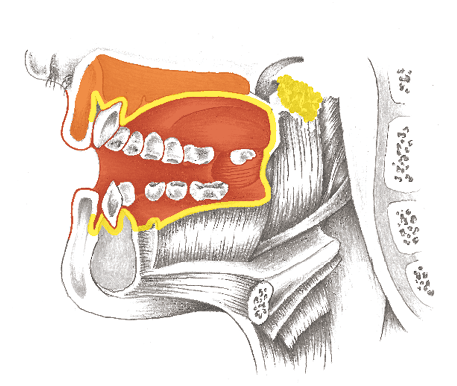
Tonsils
Chunk conflict
Oral Submucosa
Chunk conflict
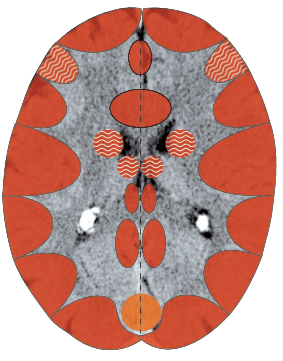
Aphthous stomatitis (canker sores)
Aphthous ulcers, also known as canker sores, are painful, dot-like ulcers of the mucosa in the mouth.
| Conflict | Separation conflict regarding the lips, mouth, or tongue. To become separated from somebody or wanting to become separated. Wanting (or not wanting) to have contact (e.g., kissing, touching). Also applies to food or dietary restrictions. Not wanting, being allowed to or being able to say something. Also not wanting to have said something. |
|---|---|
| Examples | ➜ “I can’t spit it out.”“Talk ‘till one’s blue in the face; burn one’s tongue.” A woman has suffered from aphthous ulcers of the mouth for the past 50 years. As a child, she was severely beaten for having eating nuts from her neighbor‘s garden = mouth-separation conflict. Since then she has been allergic to nuts, reacting with aphthous ulcers in the repair phase. When she recognizes the connection, she says to herself: “The nuts cannot do anything to me!“= conflict resolution. The ulcers disappear for good. (See Dr. Hamer, Was ist die Neue Medizin?) A woman has suffered from aphthous ulcers of the mouth for the past 50 years. As a child, she was severely beaten for having eating nuts from her neighbor‘s garden = mouth-separation conflict. Since then she has been allergic to nuts, reacting with aphthous ulcers in the repair phase. When she recognizes the connection, she says to herself: “The nuts cannot do anything to me!“= conflict resolution. The ulcers disappear for good. (See Dr. Hamer, Was ist die Neue Medizin?) A 45-year-old, right-handed, married patient is an avid gardener. Her husband appears with a pair of heavy-duty scissors, intending to prune the grapevine. The patient sees this and says, “You know you have to use the hedge clippers for that!“ The man hands her the scissors and says, “Here are the scissors – do it yourself!“ = separation conflict of not being able to reach (touch) the partner with words (with the tongue). She steps back without saying a word, as if she was struck by lightning and says to herself, “I will never criticize anything again because he doesn‘t get it anyway.“ = Active-phase with cell reduction of the tongue mucosa and pain. Two days later, after she has forgotten the whole matter, she develops an aphthous ulcer on the right side of the tip of her tongue (partner side) = repair phase with restoration of the mucous membrane. (Archive B. Eybl) A 45-year-old, right-handed, married patient is an avid gardener. Her husband appears with a pair of heavy-duty scissors, intending to prune the grapevine. The patient sees this and says, “You know you have to use the hedge clippers for that!“ The man hands her the scissors and says, “Here are the scissors – do it yourself!“ = separation conflict of not being able to reach (touch) the partner with words (with the tongue). She steps back without saying a word, as if she was struck by lightning and says to herself, “I will never criticize anything again because he doesn‘t get it anyway.“ = Active-phase with cell reduction of the tongue mucosa and pain. Two days later, after she has forgotten the whole matter, she develops an aphthous ulcer on the right side of the tip of her tongue (partner side) = repair phase with restoration of the mucous membrane. (Archive B. Eybl) |
| Conflict-active | Increase in the sensibility of the oral mucosa. Development of smaller or larger defects in the mucosa (aphthous ulcers). The longer the conflict lasts, the deeper they become. Pain is in the active-phase and repair phase crisis. Usually a recurring–conflict. |
| Bio. function | Increased sensibility so one doesn’t say anything inconsiderate or senses more when kissing/eating. |
| Repair phase | Restoration of the oral mucosa, inflammation, swelling, reddening. Active phases and repair phases can quickly switch. Sometimes small inflammations of the deep-lying, endodermal oral mucosa will also be diagnosed as aphthous stomatitis. In this case, pain and halitosis during the repair phase (see SBS of the oral submucosa – trench mouth, p. 215). |
| Repair crisis | Severe pain, bleeding. |
| Note | Consider “handedness“ (right or left) and side (mother/child or partner). |
| Questions | When did the symptoms begin? (Conflict shortly before). The three most important questions: Speaking/kissing/eating? (Usually it’s about speaking)? In which situations is it better/worse? Does the conflict have to do with someone? Why do I react so sensitively to this issue? With regard to this, which burdensome experience of my ancestors do I carry on? (Ask about the family history). Will I allow myself to let this go? |
| Therapy | Determine the conflict and conditioning and, if possible, resolve them in real life. Guiding principles: “My words are long since forgotten.“ “In the future, I will say what is on my mind right away.“ MMS (see p. 68). Diluted hydrogen peroxide (H2O2) internally. Gargle with of sage tea, tea tree oil, colloidal silver, EM (see p. 66), DMSO. See remedies for inflammations in the mouth p. 222. |
Squamous cell skin cancer (tumor) of the lip, mouth, gum or tongue1
Same SBS as above.
Vernacular “It‘s on the tip of my tongue!“ “I could bite my tongue!“ “Speak until one’s blue in the face.“
| Examples | • A married, left-handed woman sees her 4-year-old grandson throw a stone through a relative‘s window. The patient thinks she should inform the parents about this incident. Her husband, however, is against it, because he doesn‘t want to start an argument = conflict of not being allowed to say something. Two weeks later, the patient finds the courage to write the mother an e-mail = conflict resolution. Two days after that, a 1.5 cm swelling appears on the right side of the patient‘s mouth (mother/child side) = repair phase. After two weeks, the swelling subsides. (See www.germanische-heilkunde.at) Within a few weeks, a 67-year-old, right-handed, married mother of five, develops an approximately 8 mm wart (tongue papilloma) immediately behind the tip of the tongue = conflict of not being able to say something, in persistent repair. Conflict history: Her husband has a hot temper. For the patient, however, a peaceful and harmonious co-existence is important. She is always trying to “smooth things over.“ Often, she is about to say something, but it stops, so to speak, “on the tip of her tongue.“ After brief consideration, she holds her tongue to avoid irritating her husband. Later, through a fortunate coincidence, he discovers a new hobby in cooking. Now, the patient is starting to say what she thinks more often. (Archive B. Eybl) Within a few weeks, a 67-year-old, right-handed, married mother of five, develops an approximately 8 mm wart (tongue papilloma) immediately behind the tip of the tongue = conflict of not being able to say something, in persistent repair. Conflict history: Her husband has a hot temper. For the patient, however, a peaceful and harmonious co-existence is important. She is always trying to “smooth things over.“ Often, she is about to say something, but it stops, so to speak, “on the tip of her tongue.“ After brief consideration, she holds her tongue to avoid irritating her husband. Later, through a fortunate coincidence, he discovers a new hobby in cooking. Now, the patient is starting to say what she thinks more often. (Archive B. Eybl) |
|---|---|
| Phase | Repair phase or persistent repair: Restoration of the epithelium (= squamous cell ca). White coating (leukoplakia), swelling, possibly bleeding without pain. Pain (e.g., burning tongue) in the active-phase and in the repair phase crisis. Larger, more problematic tumors can only arise through long-lasting conflict. Often a recurring–conflict. |
| Therapy | Determine and resolve the conflict, conditioning and beliefs. For questions, therapeutic advice: see previous page. OP if necessary, without chemo or radiation. See remedies for the mouth p. 222. |
Scarlet fever (affecting the mouth)
Same SBS as above (see: p.212) and other SBS. The primary symptom for scarlet fever is inflamed, reddened mucosa of the mouth and tongue – the typical “raspberry tongue“ – and inflamed tonsils:
| Examples | ➜ A child insists on having a sweet but does not get it. ➜ A child is weaned from his pacifier. |
|---|---|
| Phase | Inflamed mucosa of the mouth, “raspberry mouth“: repair phase of a separation conflict – restoration of the squamous epithelium-mucous membrane (see: p.212). Inflamed tonsils: repair phase of a chunk conflict (see: p.216). Skin rash: repair phase of a separation conflict (see: p.332). |
| Therapy | The conflict is resolved. Support the healing. Avoid recurrences. See aphthous therapy on previous page and remedies for the mouth p. 222. |
Fever blisters (herpes simplex, herpes labialis)
| Examples | ➜ A child does not want to be kissed by his aunt. Nevertheless, he gets a big “smooch“ from her every time. > The child wants to be separated. ➜ Someone stuffs himself and regrets having overeaten afterwards > wanting to undo the lips’ contact with so much food.  A man sips a beverage with a straw. Afterwards, somebody tells him that a cat had just licked the straw. The man is disgusted = lip separation conflict. In the repair phase, he gets a fever blister. Note: It wasn‘t true at all, a cat hadn’t licked the straw. Someone was playing a trick on him. (See www.germanische-heilkunde.at/index.php/erfahrungsberichte). Also: This is a good example of how conflicts can be entirely subjective and based on one’s imagination. A man sips a beverage with a straw. Afterwards, somebody tells him that a cat had just licked the straw. The man is disgusted = lip separation conflict. In the repair phase, he gets a fever blister. Note: It wasn‘t true at all, a cat hadn’t licked the straw. Someone was playing a trick on him. (See www.germanische-heilkunde.at/index.php/erfahrungsberichte). Also: This is a good example of how conflicts can be entirely subjective and based on one’s imagination. A woman notices, with distress, that her thoughtless words have deeply hurt her partner = conflict of wishing that one hadn‘t said something. Whenever this happens, she gets a fever blister two days later = repair phase. (Archive B. Eybl) A woman notices, with distress, that her thoughtless words have deeply hurt her partner = conflict of wishing that one hadn‘t said something. Whenever this happens, she gets a fever blister two days later = repair phase. (Archive B. Eybl) |
|---|---|
| Phase | Repair phase: fever blisters, swelling, scabs, hardly any pain. In repair phase crisis pain, bleeding. |
| Note | Pain during cell degradation (ulcer), in other words before the fever blister appears. Consider mother/ child or partner side or local conflict. |
| Therapy | The conflict is resolved. Support the healing. If relapses occur, find out what the conflict and conditioning are and resolve them. Guiding principle: see above. Hydrogen peroxide (H2O2) internally. Apply salve, e.g., propolis salve (acts as a sealant), hyssop salve: add a few drops of hyssop oil to a basic natural salve, DMSO, colloidal silver. See also remedies for the mouth p. 222. |
Fissures (cracks) in the corner of the mouth (rhagades)
| Conflict | Separation conflict that one doesn’t open their mouth at the right moment. It was necessary to say something, but one remained silent. Teacher at school: “Say something, why don’t you?!” |
|---|---|
| Example |  A 25-year-old saleswoman has been suffering from a crack in the corner of her mouth since she has been together with her new partner. He tends to blow every little thing out of proportion. To keep from angering him any more and out of plain fear, she remains completely silent during these situations. = Conflict of not being allowed to open her mouth. (Archive B. Eybl) A 25-year-old saleswoman has been suffering from a crack in the corner of her mouth since she has been together with her new partner. He tends to blow every little thing out of proportion. To keep from angering him any more and out of plain fear, she remains completely silent during these situations. = Conflict of not being allowed to open her mouth. (Archive B. Eybl) |
| Phase | Painful fissures in the conflict-active phase, crusting and scabbing in the repair phase. |
| Bio. function | Increasing the sensibility of the mouth > the attention is directed to the lips so that one will finally open their mouth (wide). |
| Therapy | Determine and resolve the conflict, conditioning and belief (system). Practice expressing opinions freely. Apply ointment to the corners of the mouth, e.g., with propolis salve. See remedies for the mouth p. 222. |
1 See Dr. Hamer, Charts pp. 122, 135
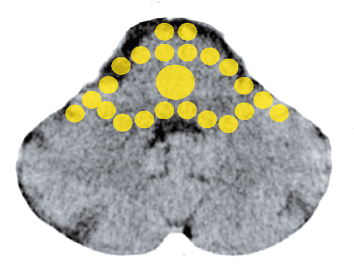
Trench mouth, thrush (candidiasis), leukoplakia, geographic tongue1
Acute necrotizing ulcerative gingivitis (ANUG), commonly known as trench mouth, is a typical pediatric illness: The oral mucosa is coated with a yellowish-white, stinking film.
| Conflict | Chunk conflict (see explanations p. 15, 16) of not being able to grasp something that one wants to have or not being able to spit out or expel something that one wants to get rid of. Simply stated: Conflict of not getting what one wants or not being able to get rid of something one doesn‘t want. |
|---|---|
| Examples |  A young woman has been wanting to switch to a vegetarian diet for years, but never succeeds. She always ends up eating hot dogs or other fast foods due to lack of time = chunk conflict of not getting the right nutrition. One day, her partner and her decide to become vegetarians = beginning of the repair phase with painful oral thrush of the gums.(Archive B. Eybl) A young woman has been wanting to switch to a vegetarian diet for years, but never succeeds. She always ends up eating hot dogs or other fast foods due to lack of time = chunk conflict of not getting the right nutrition. One day, her partner and her decide to become vegetarians = beginning of the repair phase with painful oral thrush of the gums.(Archive B. Eybl) In the beginning, a new mother has breast-feeding problems. For the first few days, the baby remains hungry = chunk conflict of not getting the food (milk). When the child finally gets full, it develops thrush (candidiasis) > a very common situation. (Archive B. Eybl) In the beginning, a new mother has breast-feeding problems. For the first few days, the baby remains hungry = chunk conflict of not getting the food (milk). When the child finally gets full, it develops thrush (candidiasis) > a very common situation. (Archive B. Eybl) |
| Conflict-active | Growth of a lawn-shaped flat tumor (usually unnoticed) under the squamous epithelium of the oral mucosa = adeno-ca. |
| Bio. function | To produce more mucous with more (intestinal) glandular cells, so that the “chunk“ can better slip in or out of the pharynx. |
| Repair phase | Tubercular caseating degradation of tissue – white patches, so-called plaques, appear. In CM, this can sometimes be diagnosed as leukoplakia. Halitosis = trench mouth. |
| Therapy | The conflict is resolved. Support the repair phase and avoid relapses. See also remedies for the mouth p. 222. |
Cancer of the palate (palatal adeno-ca)1
| Conflict | The same conflict as with SBS of the oral submucosa. See above. |
|---|---|
| Example |  Someone thinks he has won the lottery, but the lottery license shop has incorrectly registered his ticket. Chunk conflict of not being able to get the jack-pot. (See Dr. Hamer, Charts, p. 19) Someone thinks he has won the lottery, but the lottery license shop has incorrectly registered his ticket. Chunk conflict of not being able to get the jack-pot. (See Dr. Hamer, Charts, p. 19) |
| Conflict-active | Growth of a cauliflower-like tumor of secretory quality or a flat-growing tumor (adeno-ca) of absorptive quality under the epithelial mucosa of the mouth. |
| Bio. function | To produce more mucous with more (intestinal) glandular cells, so that the “chunk“ can better slip in or out of the pharynx. |
| Repair phase | Stinking tubercular caseation of the tumor. Degradation via fungi, or bacteria (mycobacteria). Possible white patches (leukoplakia), pain, halitosis, rotten taste in the mouth. |
| Therapy | Questions: see tonsillitis. Find out what the conflict and conditioning are and, if possible, resolve them in real life if they are still active. OP if necessary. See also remedies for the mouth p. 222. |
1 See Dr. Hamer, Charts pp. 19, 31

Tonsil infections (angina, tonsillitis, angina tonsillaris),
tonsil cancer (adeno-ca), pharyngeal polyps1
Together, the adenoids (pharyngeal tonsils) and the tubal, palatine and lingual tonsils form Waldeyer’s tonsillar ring. The tonsils are lymphatic sensors that determine if something about to be swallowed is fit to swallow. With increasing age, the tonsils shrink, because they have fulfilled their task (childhood learning and conditioning phase).
| Conflict | Chunk conflict (see explanations p. 15, 16), not being able to sufficiently verify an incoming chunk. Put simply: one can/may not verify (assess) if the thing that one is swallowing is good or bad. |
|---|---|
| Conflict | that one is confronted by accomplished facts (without being allowed to verify them). (“You’ll eat everything!”) One cannot just “row their boat gently down the stream” of life, rather, one wants to do everything their own way. (“I want…, I want…”) |
| Example | ➜ A child is forced to eat something he doesn‘t like. > Thus, their instincts are violated by force. Conflict that one cannot judge what is good for them for themselves. A girl is weaned from the breast at the age of six months. She suffers a chunk conflict with respect to the tonsils and the sub-mucosa of the oral cavity. Three months later, when she is accustomed to not receiving breast milk, she gets oral thrush and shortly thereafter tonsillitis = repair phase of the two chunk conflicts. (Archive B. Eybl) A girl is weaned from the breast at the age of six months. She suffers a chunk conflict with respect to the tonsils and the sub-mucosa of the oral cavity. Three months later, when she is accustomed to not receiving breast milk, she gets oral thrush and shortly thereafter tonsillitis = repair phase of the two chunk conflicts. (Archive B. Eybl)a Because of her demanding job, a woman going on 50 postpones a the restoration work she needs on two dental crowns. Then, she finally has her first dentist’s appointment: After three injection attempts, her dentist fails to anesthetize her tooth – she is sent home without getting the dental work done. At her next appointment, the same thing happens again! (= morsel conflict, not being able to complete the crown restoration.) After these disappointments, she looks for a new dentist and, lo and behold, the new one is not only friendly, but also competent (= conflict resolution). The two follow-up appointments must be postponed due to severe tonsil pain (= resolved morsel conflict) and a cold (= resolved stink conflict). (Archive B. Eybl) |
| Conflict-active | Increasing the sensibility of the brainstem through enlargement of the tonsil’s surface area = enlarged tonsils, pharyngeal polyps. Possibly difficulty with swallowing or breathing. |
| Bio. function | The enlarged surface area and increased sensibility makes a better assessment of the food “chunk.” |
| Repair phase | Normalization of function, stinking, tubercular caseation of the tumor via fungi or bacteria = tonsillitis. Tightening of the pharynx due to healing swelling. Aggravated by syndrome. Pain, swelling, halitosis, purulent tonsils, tonsil abscess, mild fever and night sweats. |
| Note | Increasingly, patients are being diagnosed with “tonsillar cancer“ instead of tonsillitis or enlarged tonsils. A portion of the tonsil consists of lymphatic tissue > combination tonsil SBS + lymph SBS (for this reason, see: p.180). |
| Questions | In the case that a child is affected: When did they have their first tonsillitis? (Find the original conflict, but keep in mind that it could also be a substitution conflict – a parent has a conflict and the child carries (materializes it in themselves) > ask about the child’s and the parent’s stress) E.g., didn’t get a toy/favorite food, parents fight. What brought on the repair phase? (E.g., got the food/toy). What was the conflict situation for this episode? (Work out the similarity to the original conflict). Which event sensitized the child? (Conditioning, e.g., through the character of the parents, pregnancy, birth). |
| Therapy | In the case that it is recurring: Determine and resolve the conflict, conditioning and belief (system). Guiding principles: “I am open for surprises – life is wonderful.” “Sometimes you get something you weren’t expecting – I want to accept and appreciate my gifts.” In children, tonsillitis tends to stop by a certain age, when they learn to accept the things they don’t have the power to change. (E.g., that they have to listen to the parents, that they don’t get an ice cream immediately). If the patient is a child with a substitution conflict, the parent(s) should resolve the conflict and then explain to the child that they do not have to carry it anymore (see: p. 27ff). Gargling with colloidal silver. If necessary, use chinstrap while sleeping so that the mouth is closed. This offers a chance to improve recovery for enlarged tonsils. Surgery if the conflict recurs repeatedly and the tonsils are too abscessed. See also remedies for the mouth p. 222. |
1 See Dr. Hamer, Charts pp. 19, 32.

Inflammation of the pharynx (pharyngitis)
Common SBS with “infections,“ colds, the flu.
| Conflict | Separation conflict, not wanting to swallow something, wishing to spit it out again (e.g., hostilities, accusations, insults). “That is hard to swallow!“ Also, separation conflict of not being allowed to swallow a certain food – for example, when on a diet. |
|---|---|
| Examples | ➜ A woman must “swallow“ a lot at the company where she works. On vacation she comes down with laryngitis during the repair phase. ➜ A child is not allowed to eat sweets. Instead, he should eat his vegetables > not wanting to swallow the vegetables. ➜ A person is constantly being reproached by his partner > wanting to spit out the accusations > cell reduction of the pharyngeal mucosa in the active–phase and restoration in the repair phase.  A schoolboy must study math every day; otherwise he will not pass > not wanting to “swallow” the learning material. As vacation approaches, he enters the repair phase > pharyngitis. A schoolboy must study math every day; otherwise he will not pass > not wanting to “swallow” the learning material. As vacation approaches, he enters the repair phase > pharyngitis.a A 45-year-old, self-employed man takes his job extremely seriously and wants to please all his customers. He is fully committed both emotionally and in terms of time. Success proves him right, but during periods of rest (vacations) he regularly pays the price for his excessive exertions: fever, aching limbs, and pharyngitis. = healing phase symptoms. When he decides to significantly reduce his workload, pharyngitis sets in and lasts almost half a year. = Profound healing of the conflict: He would prefer to say no and would prefer NOT to swallow everything. With a therapist, he finds out that his instinctive will to overachieve came from childhood conditioning: As a boy, he hungered for praise from his aggressive father. (Archive B. Eybl) |
| Conflict-active | Increased sensitivity, later cell degradation (ulcer) in the pharyngeal squamous epithelium with pain. |
| Bio. function | Through the high sensibility, one has a better sense of what they want to swallow and what not. |
| Repair phase | Restoration of the mucosa defects = pharyngitis. Swelling, difficulty swallowing, aggravated by syndrome. |
| Repair crisis | Severe pain, possibly lasting several days, chills. |
| Questions | Inflammation since when? (Resolution of the conflict, e.g., through a discussion, relaxing on the weekend, through attending to others). What did I not want to swallow before? Was this the first episode? (If no, go back and locate the first time this conflict was experienced = original conflict). What has conditioned me? (E.g., childhood). |
| Therapy | The conflict is resolved. Support the healing. In case of a relapse, find out what the conflict and conditioning are and resolve them. Guiding principle: “I only swallow what is good for me!“ “I won’t let anybody force something upon me that I don’t want.“ See also remedies for the mouth p. 222. |

Tumor or inflammation (sialadenitis) of the parotid,
sublingual and submandibular salivary glands1
Most people affected by sialadenitis are between the ages of 20 and 50. Up to 80% of the cases are parotitis, the other salivary glands are only involved in approximately 20% of the cases.
| Conflict | The same conflict as with the SBS of the oral submucosa (see above). |
|---|---|
| Example | ➜ A child must eat all their food, even though they are already full. ➜ A child wants a certain toy, but does not get it. This often happens in kindergarten, when an only child suddenly has to share with other children.  A father of a very underweight, young son says he thinks the boy is suffering from bulimia nervosa (binge eating followed by vomiting). He can’t think of anything else > Can’t ingest the chunk, felt in substitution for his son. In the active phase, a tumor of the salivary gland develops. (Archive B. Eybl) A father of a very underweight, young son says he thinks the boy is suffering from bulimia nervosa (binge eating followed by vomiting). He can’t think of anything else > Can’t ingest the chunk, felt in substitution for his son. In the active phase, a tumor of the salivary gland develops. (Archive B. Eybl) A 44-year-old patient leases a small farm from a farmer, so that he can live there with his family. When the key is handed over and the family wants to move in, the farmer shows up drunk and is very unfriendly. He says that before they can move in, they must “wash the windows.“ Over the following months, the patient can take little pleasure in the house, because the landlord is constantly meddling = chunk conflict of not being able to savor (insalivate) the “house-chunk.“ In the end, they communicate only through their lawyer and the lease is canceled at the first opportunity. During this time, a tumor of the parotid salivary gland develops on the right side. The patient is familiar with the 5 Biological Laws of Nature and accepts the diagnosis serenely. Within 6 years, the tumor disappears completely – by itself – without inflammation. (Archive B. Eybl) A 44-year-old patient leases a small farm from a farmer, so that he can live there with his family. When the key is handed over and the family wants to move in, the farmer shows up drunk and is very unfriendly. He says that before they can move in, they must “wash the windows.“ Over the following months, the patient can take little pleasure in the house, because the landlord is constantly meddling = chunk conflict of not being able to savor (insalivate) the “house-chunk.“ In the end, they communicate only through their lawyer and the lease is canceled at the first opportunity. During this time, a tumor of the parotid salivary gland develops on the right side. The patient is familiar with the 5 Biological Laws of Nature and accepts the diagnosis serenely. Within 6 years, the tumor disappears completely – by itself – without inflammation. (Archive B. Eybl) |
| Conflict-active | Increased function, growth of a cauliflower-life tumor (adeno-ca) of secretory quality. Enlargement and increase in capacity of the salivary gland. Possibly a recurring conflict. |
| Bio. function | Production of more saliva, so that the “chunk“ can be ingested in or be expelled. |
| Repair phase | Function normalization, tubercular caseation, stinking saliva, halitosis, pain, inflammation, reduction (melting away) of the tumor via fungi (mycosis) or bacteria = inflammation of the salivary gland, mild fever, night sweats. |
| Repair crisis | Severe pain, chills. |
| Therapy | Find out what the conflict and conditioning are and, if possible, resolve them in real life if they are still active. Guiding principle: “I don‘t expect anything. I can‘t have everything. I fully accept everything the way it is.“ Soften white cabbage leaves and apply. Oil pulling (see p. 68). Chew chewing gum to stimulate salivation and the purification of the gland. See also remedies for the mouth p. 222. |
Dry mouth (mucoviscidosis of the salivary glands)1
Same SBS as above.
| Phase | Persistent repair or the condition thereafter. Scarred degeneration of the glandular tissue due to recurrences > insufficient production of saliva. More common are the other reasons listed below. |
|---|---|
| Note | The frequent dryness of the mouth following menopause usually goes hand in hand with a lowering of the estrogen level (dryness of the mucous membranes). Increased dry mouth with active kidney collecting tubules. Radiation or radiation therapy can damage the mucous membrane and lead to dry mouth. Also, medications like antihypertensives, anti-depressants, diuretics and alcohol abuse can cause these symptoms. Dry mouth can be an indication of diabetes. |
| Therapy | Find out what the conflict and conditioning are and, if possible, resolve them in real life so that the persistent repair can come to an end. Oil pulling and lymph drainage massage (see p. 68) , so that the juices start flowing again. Gargling with natural salt solution, Symbioflor 1, or EM. See remedies for the mouth p. 222. |
Salivary gland cysts
These usually appear in the small salivary glands distributed throughout the mouth. For example, they can be caused by a bite on the upper lip > mucus collects and then solidifies (mucocele). If there is no injury: same SBS as above.
| Phase | Completed healing or state following relapse. The completely removed tumor leaves an empty space (cyst). With syndrome, the cyst can be “pumped up“ again. |
|---|---|
| Therapy | The conflict is resolved. Avoid relapse and resolve refugee conflict, if still active. OP if necessary. See also remedies for the mouth p. 222. |
1 See Dr. Hamer, Charts, pp. 20, 31
Salivary Gland Excretory
Ducts (Mumps)
Not being allowed to
or not wanting to
eat something
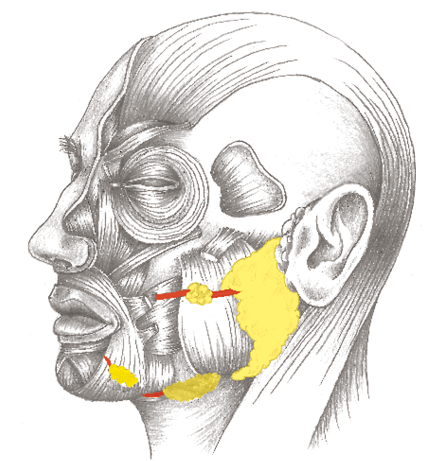
Salivary Glands
Chunk conflict
Inflammation of the parotid salivary gland ducts (mumps)1
According to CM, mumps affects the parotid salivary glands. However, according to Dr. Hamer, mumps is an inflammation of the parotid salivary gland excretory ducts.
| Conflict | Not being able to, not being allowed to, or not wanting to eat something (moisten it). |
|---|---|
| Example | ➜ A child is forced to eat everything. “You will eat everything on your plate!“ |
| Conflict-active | Functional limitation, later, cell degradation (ulcer) in the squamous epithelium of the duct, painful pulling sensation. |
| Bio. function | Larger diameter > better excretion of saliva, better insalivation of food. |
| Repair phase | Swelling and reddening of the ducts. Possible occlusion and build-up of secretions = mumps – they look like an inflammation of the glands. Aggravated by syndrome. |
| Note | It is hard to tell the difference between mumps and an inflammation of the parotid salivary glands. Consider “handedness“ (right or left) and side (mother/child or partner) or local conflict. |
| Therapy | The conflict is resolved. Support the healing. Avoid recurrences! Chew gum to stimulate salivation and the purification of the gland. See also remedies for the mouth p. 222. |
1 See Dr. Hamer, Charts, pp. 123, 136
Right
cyst
Left
cyst
Medial neck cysts (thyroglossal duct cysts)
These cysts are found on the existing remains of the thyroglossal ducts, on the center line of the body between the base of the tongue, the larynx and the thyroid. Powerlessness conflict (see: p. 147) or frontal-fear conflict (see: p.181, 207).
| Phase | Persistent repair: healing swelling of the thyroid’s excretory ducts. Therapy: See also p. 147. |
|---|
Right
cyst
Left
cyst
Side (lateral or branchiogenous) neck cyst or fistula
We normally think of the lymph nodes when the neck swells. In rare cases, however, this can be a lateral neck cyst. They are usually situated on the anterior surface of the sternocleidomastoid muscle, also known as the sternomastoid or SCM.
| Conflict | Powerlessness conflict (see: p. 147) or frontal-fear conflict (see: p.181, 207). |
|---|---|
| Phase | Repair phase: Restoration of the squamous epithelium. During the repair swelling, the fluid can collect in cysts. If a cyst opens outwards, it is called a lateral (branchiogenous) neck fistula. Usually recurring conflict. |
| Therapy | The conflict is resolved. Support the healing. Avoid recurrences. Lymph drainage massages (see p. 68). |
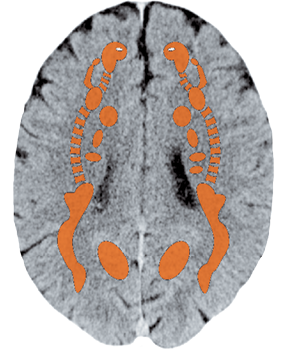
Cleft lip, jaw or palate (harelip, orofacial cleft)
One of the most common birth defects: An incomplete joining of the left and right nose or upper jaw plates in the embryonic stage. As with all hereditary diseases, our focus is directed to the parents and family.
| Conflict | According to Frauenkron-Hoffmann: Self-esteem conflict, one doesn’t need a palate, because they are unable to get/swallow a chunk anyway. Substitute conflict (look among the parents/ancestors). Resignation with regard to survival/getting by. |
|---|---|
| Conflict-active | Limited connection of the tissue halves during embryonic development. |
| Repair phase | A closure of the cleft – making up for the development – is probably only possible during pregnancy. Restoration after birth without an OP cannot be ruled out, but is yet to be documented (own research). |
| Bio. function | A biological function for the individual is not recognizable. This defect should bring the issue to the family’s attention and, like every handicap, has the potential of providing great learning and developmental opportunities for all. |
| Questions | Did any ancestors already experience this birth defect? Does this issue correspond with any of the ancestors? Was there conflict/resignation during the pregnancy in the sense of: “I/we am/are not going to get through this anyway?” |
| Therapy | Determine and resolve the cause of the conflict and original conditioning so that the issue is healed within the family. This procedure undoubtedly also requires the healing after the (probably necessary) OPs. |

Paralysis of the tongue
A complete paralysis practically only occurs in the case of a stroke (paralysis of the hypoglossal nerve), but in these cases, one is also dealing with the underlying conflict. A partial paralysis manifests itself with the outstretched tongue leaning toward the paralyzed side.
| Conflict | Motor conflict of not wanting, being allowed or being able to say something. Wishing that one had not said something. “I should have bitten my tongue.” “If I just wouldn’t have said anything.“ Not being able to reach something with the tongue (e.g., lack of food). |
|---|---|
| Example | a A 60-year-old farmer’s wife notices one day that she can no longer speak properly – her voice has faded out. Singing is particularly difficult, so much so, that she has to quit the church choir. In the hospital, the doctors can’t decide between a diagnosis of a stroke or ALS (see p. 378). The neurologist decides in favor of ALS when he measures “nerve irritation disorders” in her leg (> diagnosis shock). With the help of a therapist, she figures out the cause: Her father, who died 30 years ago, never spoke about things openly. This is common in her family, and she is carrying on the tradition. E.g., she always feels resentful toward her husband because he goes to the pub too often for her taste and rarely shows an interest in her, but she never speaks out about this. She always keeps her mouth shut and stifles it. Before the onset of her symptoms, she entered a good phase: She thought to herself, “Oh, how nice I have it now – my husband is much nicer, too.” This was followed by heavy night sweats and the speech difficulties described above. = Strong healing phase. The correct diagnosis would have been “hot stroke,” see p. 98. (Archive B. Eybl) |
| Phase | Paralysis in the conflict-active phase. Slow restoration in the repair phase. With a hot stroke, the conflict is already in the repair phase. (Paralysis through the enlargement of the synapses in the motor cortical center.) |
| Questions | Paralysis since when? Conflict-active indication (compulsive thought, poor sleep, cold hands) or repair phase indication (psychically resolved, headache, warm hands) in the context of a hot stroke? Which stress was there in regard to speaking/speech? Did I say something wrong/I shouldn’t have said or was I afraid to speak? Why am I sensitized here? Similar characteristics in ancestors? |
| Therapy | Find out what the conflict and conditioning are and resolve them in real life. |
Bad Breath (Halitosis)
Possible Causes
• Poor oral hygiene (cavities, periodontitis, p. 226ff)
• Coated tongue > brush tongue regularly with toothbrush
• Tonsilitis (p. 216) or oral thrush (p. 215)
• Throat or salivary gland inflammation (p. 217, 218)
• Poor bodily excretory function/poisoning (see kidneys p. 277 and liver p. 263
• Less often: SBSs of the stomach play a role (p. 233ff)
• Foul-smelling exhaled air when mouth is closed may be from nasal polyps or lung disease.
• Inexplicable bad breath can indicate the following issues: malicious gossip, corrupt thoughts, thoughts of anger and revenge. (t.me/UweEggers)
Therapy: according to the cause.
Sialolithiasis (salivary (duct) stones)
This is most often found (in 80% of cases) in the excretory ducts leading from the parotid salivary glands.
Possible causes
- Recurring inflammation of the salivary gland – persistent repair or condition following persistent repair. (See: p.218.) At the end of every tubercular repair, calcium deposits remain. Scarring degeneration of the glandular tissue due to recurrence > thickening and clumping of the saliva and deposition of minerals > salivary stones.
- Recurring inflammation of the excretory ducts – persistent repair of the excretory ducts and condition following persistent repair. (See: p.219.) Repeated inflammation and congestion in the excretory ducts > clumping, thickening > mineral deposits > salivary stones.
Remedies for inflammations in the mouth and throat
- Tea: fenugreek, chamomile, agrimony, sage, burdock root, anise, common mallow, horsetail, etc.
- Oil pulling (see p. 68).
- Gargle with colloidal silver.
- Swedish bitters – “pull“ or swish in the mouth, gargle and then swallow.
- Vitamin D3, cod liver oil (see p. 68).
- MMS (see p. 68).
- DMSO.
- Gargling remedy: Natural salt solution, diluted or concentrated, swish in mouth for 10 min. then spit out.
- Gargling remedy: Boil nut shells and oak bark and then allow them to steep for several hours; then drain and store in a cool place. Swish in the mouth and gargle several times a day.
- Symbioflor 1, EM (see: p. 66) or bread drink (Brottrunk) for symbionts.
- Curd cheese compress for the neck. Lymph drainage massages (see p. 68).
All experience reports on the organ system “Lips, mouth, and throat” from the International Report Archive:
| Author | Title and Overview | Keywords | ||||
|---|---|---|---|---|---|---|
 | 2025/11/06   Since trouble after illegally helping myself to the family and brothers' chocolate stash, painful mouth ulcers and resolution of these symptoms solely through knowledge and awareness of the 5 Biological Laws of Nature. | Separation conflict on the oral mucosa | ||||
 | 2025/09/18    A 33-year-old man came to me for advice. He complained of allergies: for many years, he had been unable to eat any carbohydrate-rich foods, even the simplest ones such as potatoes, pasta, and rice. If he tried even a small amount, he would develop a rash on his hands and blisters on his head. Over time, the situation worsened: eating a normal diet became impossible, and shared dinners, trips to cafes, and guests became a real challenge. He did not remember his conflict, so I had to work with him differently.  | allergy, epidermis, carbohydrates | ||||
 | 2025/08/16   The reason Sergej (name changed) consulted me for help was because of his panic attacks while driving. During the anamnesis, he reported that he could no longer drive a car or truck for more than about 15 minutes... | |||||
2025/03/22   Last weekend, I visited my mother. I talk quite openly with her about my views, even though she sees many things differently and is very influenced by mainstream opinion... | ||||||
 | 2024/12/15   The case comes from a participant (she is a music school teacher) from our study group who helped a 14-year-old student to improve her recurring migraines. | Frontal anxiety, migraine, gill arches | ||||
2024/10/08   Unpleasant sensation when kissing due to prickly stubble | ||||||
 | 2024/08/17   My daughter is 19 years old and will be starting university in September. She always wanted to be a doctor from an early age, but confessed to me about 3 weeks ago that she has wanted to be a teacher for a while now ... | Angina | ||||
 | 2024/04/24   Tonsillitis/angina bilateral information-chunk conflict with syndrome | |||||
 | 2023/03/18   A few months ago I got an aphthae under my tongue, a single one, but very large. Aphthae hurt a lot. I looked in Björn's book: “Not being able to say something that was important to me.” ... | |||||
 | 2023/02/04    The client had already had one of the canines in a repeated repair process for a few days. When she woke up one morning, she discovered an extra swelling on this side of her face in the cheek and upper jaw area. In the mouth area, she felt a thicker, more swollen strand above the affected tooth. | |||||
 | 2022/11/29   After moving from the 5th floor to a basement apartment with a small adjoining garden, my cat developed throat problems. | Cat, chunk conflict, free access | ||||
 | 2022/05/22   On a day in May 2022 early in the evening, a client noticed that her mouth seemed particularly dry in the front area by the tongue, below the tongue area and to the side of it. This dryness lasted for a few hours and did not go away during this time even by drinking fluids. Only dryness was noticeable, no redness or other symptoms in the mouth area. |
